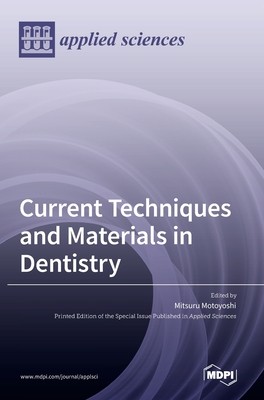
- We will send in 10–14 business days.
- Publisher: MDPI AG
- ISBN-10: 3036544135
- ISBN-13: 9783036544137
- Format: 17 x 24.4 x 1.6 cm, hardcover
- Language: English
- SAVE -10% with code: EXTRA
Current Techniques and Materials in Dentistry (e-book) (used book) | bookbook.eu
Reviews
Description
With advances in dental materials and their clinical applications, as well as innovations in computer technology, dental treatment is constantly evolving. In particular, adhesion technology to the tooth surface, implant treatments, and the application of CAD/CAM technology are very interesting topics for clinical dentists. As a bonding technique, the influence of the pre-etched area of the tooth surface on the adhesive strength can be reduced by the new application of a functional monomer. Additionally, the effect of an advanced adhesive system as a universal adhesive-derived primer, when compared with the two-step adhesive, is helpful for updating the applications of new materials. Dental implants are one of the most interesting dental treatments. PEEK (polyetheretherketone) has recently been reported as a further innovation in polymer implant materials, although it has not yet met the requirements to be a biomechanical requirement. In the placement of mini-screws used in orthodontic treatments, micro-cracks caused by overtorquing in thick and hard bone, and the consequent heat production, can reduce the success rate. Computer-aided design/computer-aided manufacturing (CAD/CAM) techniques are becoming increasingly popular. Since complete dentures can be produced using an additive (3D printing) or subtractive (milling) process, CAD/CAM techniques for denture fabrication have many clinical and laboratory advantages. Innovative and convenient dental material technology will be more and more expected in the future. This book has limited findings, but we hope that your clinical capability will be integrated and upgraded.
EXTRA 10 % discount with code: EXTRA
The promotion ends in 8d.10:39:22
The discount code is valid when purchasing from 10 €. Discounts do not stack.
- Publisher: MDPI AG
- ISBN-10: 3036544135
- ISBN-13: 9783036544137
- Format: 17 x 24.4 x 1.6 cm, hardcover
- Language: English English
With advances in dental materials and their clinical applications, as well as innovations in computer technology, dental treatment is constantly evolving. In particular, adhesion technology to the tooth surface, implant treatments, and the application of CAD/CAM technology are very interesting topics for clinical dentists. As a bonding technique, the influence of the pre-etched area of the tooth surface on the adhesive strength can be reduced by the new application of a functional monomer. Additionally, the effect of an advanced adhesive system as a universal adhesive-derived primer, when compared with the two-step adhesive, is helpful for updating the applications of new materials. Dental implants are one of the most interesting dental treatments. PEEK (polyetheretherketone) has recently been reported as a further innovation in polymer implant materials, although it has not yet met the requirements to be a biomechanical requirement. In the placement of mini-screws used in orthodontic treatments, micro-cracks caused by overtorquing in thick and hard bone, and the consequent heat production, can reduce the success rate. Computer-aided design/computer-aided manufacturing (CAD/CAM) techniques are becoming increasingly popular. Since complete dentures can be produced using an additive (3D printing) or subtractive (milling) process, CAD/CAM techniques for denture fabrication have many clinical and laboratory advantages. Innovative and convenient dental material technology will be more and more expected in the future. This book has limited findings, but we hope that your clinical capability will be integrated and upgraded.


Reviews